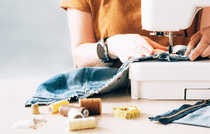They don’t make things like they used to—but why?
How many times have you replaced a broken toaster or blender? How about a TV or microwave? Over the last several decades, consumers in the US have grown accustomed to buying new products when the old ones break. But when did we switch from embracing an ethic of “Preserve and repair” to “Let’s throw it out and buy a new one”?
This cultural shift occurred in part because many of the big brands we know and purchase have actively discouraged consumers from gaining the parts and info they need to fix their products. They do this by making parts and manuals proprietary or available only to those within the companies’ own repair services.
In addition, the costs of creating electronic goods has gone down over time, and “planned obsolescence,” where companies intentionally design products with a short life span to increase product value and secure long-term profits, has become the norm embraced by large product manufacturers.
Why repair instead of buying new?
When we casually discard a broken product, we not only add to the growing problem of electronic waste (e-waste), clothing waste, and plastic waste around the world—we also waste all the energy and materials that went into making the product. These materials are often made of natural resources that have taken thousands of years to develop, and extracting them can have devastating effects on public health and the environment. Here are a few examples:
- Electronics can contain a host of precious metals that can only be found in remote areas of the world, often through mining tactics that are exploitative and unsafe for workers and harmful to surrounding ecosystems.
- Plastic Appliances and other plastic products are made from petroleum, which is nonrenewable and takes thousands of years to form. When it is drilled and refined, petroleum can wreak havoc on ecosystems and public health.
These products are intricately made of a host of materials that have had long, arduous, wasteful journeys. Repairing products gets the most use out of them, extending their lives and further preserving and valuing the precious natural resources used to create them.
The Right to Repair Movement
The “Right to Repair” movement believes consumers have the right to repair the products they own. They’ve built a coalition of consumers, repair businesses, and other advocates that create and share repair resources such as fix-it manuals and videos, which come in handy if you have the time and the will to fix something yourself.
Here’s a list of resources that will help guide you in fixing your electronics, toys, pieces of clothing, or other items you want to keep in use.
Boulder, Colorado’s Local Repair Clinic
The Boulder U-Fix-it Clinic offers trained “fixers” who help guide you in repairing your own products. These events are free of charge and family-friendly.
- Boulder U-Fix-it Clinic’s volunteer website: Boulder U-Fix-it Clinic
Other Repair Clinics Around the US
- Harvard University Fix-It Clinic
- Hennepin County, Minnesota, Fix-It Clinic
- Washington County Library Fix-It Clinic
- Ramsey County, Minnesota, Fix-It Clinic
- Dakota County, Minnesota, Fix It Clinic
- Jamaica Plain, Boston Fixit Clinic
- Flagstaff, Arizona Fix-It Clinic
- Missoula, Montana Fixit Clinic
Websites That Can Help Guide You in Fixing Broken Products Yourself
iFixit
This extensive website has three major parts: 1) a wiki section with guides to fixing just about anything, 2) a store where you can purchase essential fixing tools and repair kits for devices like iPhones, Androids, MacBooks, and PCs, and 3) an advocacy wing that fights for consumer repair rights.
DoItYourself
Search a vast library of wikis containing how-to-repair knowledge, get guidance on home projects, and explore DIY forums.
Repair Clinic
An authorized dealer for more than four million replacement parts. You can also search their extensive troubleshooting guide and how-to guides and videos to learn how to repair appliances and other household items yourself.
Know of a great repair resource?
Share it with us! Contact us here.























